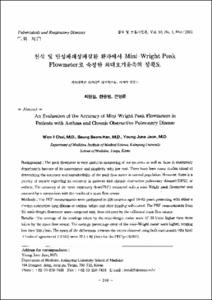KUMEL Repository
1. Journal Papers (연구논문)
1. School of Medicine (의과대학)
Dept. of Internal Medicine (내과학)
천식 및 만성폐쇄성폐질환 환자에서 Mini-Wright Peak Flowmeter로 측정한 최대호기유속의 정확도
- Keimyung Author(s)
- Choi, Won Il; Han, Sung Beom; Jeon, Young June
- Journal Title
- 결핵 및 호흡기 질환
- Issued Date
- 2001
- Volume
- 50
- Issue
- 3
- Abstract
- Background : The peak flowmeter is very useful in monitoring of out-patients as well as those in emergency departments because of its convenience and simplicity with low cost. There have been many studies aimed at determining the accuracy and reproducibility of the peak flow meter in normal population. However, there is a paucity of reports regarding its accuracy in patients with chronic obstructive pulmonary disease(COPD) or asthma. The accuracy of the peak expiratory flow(PEF) measured with a mini-Wright peak flowmeter was assessed by a comparison with the results of a mass flow sensor. Methods : The PEF measurements were performed in 108 patients aged 19-82 years presenting with either a chronic obstructive lung disease or asthma before and after inhaling salbutamol. The PEF measurements from the mini-Wright flowmeter were compared with those obtained by the calibrated mass flow sensor. Results : The average of the readings taken by the mini-Wright meter were 37-39 l/min higher than those taken by the mass flow sensor. The average percentage error of the mini-Wright meter were higher, ranging less than 300 l/min. The mean of the differences between the values obtained using both instruments (the bias)$\pm$ 수식 이미지limits of agreement(${\pm}2$ 수식 이미지 SD) were $37.1{\pm}90\;l/min$ 수식 이미지 for the PEF(p<0.001). Conclusions : The mini-Wright peak flowmeter overestimated the flows in patients with COPD or asthma. It was also found that the accuracy of the mini-Wright peak flowmeter decreased in its mid to low range. The limits of agreement are wide and the difference between the two instruments is significant. Therefore, the measurements made between the two types of machines in patients with asthma or COPD cannot be used interchangeably.
키워드
Peak expiratory flow; mini-Wright peak flow meter; Accuracy; COPD; Asthma
연구배경 : 천식의 치료에 널리 사용되고 있는 호기유속측정기는 외래환자와 응급실에서뿐만 아니라 입원 천식환자들의 치료 및 경과 관찰에 매우 유용하다. 호기유속측정기에 대한 정확도 및 재현성에 대한 많은 연구가 있어왔으나 기류폐색을 가지는 환자를 대상으로 측정했을때의 정확도에 관한 연구는 드물다. 따라서 만성폐쇄성폐질환 또는 천식을 가지는 환자를 대상으로 잘 보정된 mass flow sensor의 최대호기유속 측정치와 mini-Wright peak flowmeter의 측정치를 비교하여 정확도를 관찰하고자 본 연구를 계획하였다. 방 법 : 천식 및 만성페쇄성폐질환으로 진단된 환자 108명을 대상으로 흡입용 기관지확장제 사용 전 후의 최대호기유속을 측정하였으며 잘 보정된 mass flow sensor로 측정한 후 mini-Wright peak flowmeter를 사용해서 최대호기유속을 측정하였다. 결 과 : 천식 및 만성폐쇄성폐질환 환자에서 mini-Wright peak flowmeter로 측정한 최대호기유속 값은 기관지 확장제 사용 유무에 관계없이 mass flow sensor의 측정치보다 평균 37-39 l/min 높게 관찰되었고 300 l/min 이하의 범위에서 오차는 25% 이상이었고 301 l/min 이싱에서는 17% 이하로 관찰되었다. 두 기기로 측정한 값의 일치도를 평가할 수 있는 편의(bias)는 전체를 대상으로 했을 때와 유속의 정도에 따라서도 모두 일치범위를 벗어나고 통계적으로도 유의하게 차이가 있었다. 결 론 : 천식 및 만성폐쇄성폐절환 환자에서 mini-Wright peak flow meter로 측정한 최대호기유속은 mass flow senor의 측정치보다 높게 관찰되었으며 300 l/mm이하의 유속에서 오차가 심했다. 두 기계로 측정한 최대호기유속 사이의 일치범위는 95% 신뢰구간에서 통계적으로 유의한 차이가 있었으므로 mass flow sensor 와 mini-Wright peak flow meter로 측정 한 결과를 상호교환적으로 사용할 수 없다고 판단된다.
- Alternative Title
- An Evaluation of the Accuracy of Mini-Wright Peak Flowmeters in Patients with Asthma and Chronic Obstructive Pulmonary Disease
- Publisher
- School of Medicine
- Citation
- 최원일 et al. (2001). 천식 및 만성폐쇄성폐질환 환자에서 Mini-Wright Peak Flowmeter로 측정한 최대호기유속의 정확도. 결핵 및 호흡기 질환, 50(3), 310–319. doi: 10.4046/trd.2001.50.3.310
- Type
- Article
- ISSN
- 1738-3536
- 파일 목록
-
-
Download
 oak-bbb-00178.pdf
기타 데이터 / 647.67 kB / Adobe PDF
oak-bbb-00178.pdf
기타 데이터 / 647.67 kB / Adobe PDF
-
Items in Repository are protected by copyright, with all rights reserved, unless otherwise indicated.